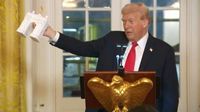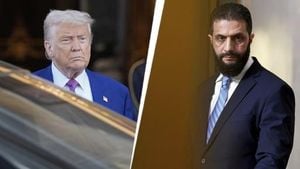On October 15, 2025, President Donald Trump ignited both admiration and controversy with a pair of bold proposals for new monuments near the heart of the nation’s capital. Speaking to a select group of wealthy executives and donors gathered for a fundraising dinner in the State Dining Room of the White House, Trump outlined his vision for a grand arch—modeled after the Arc de Triomphe in Paris—along the Potomac River near the Arlington Memorial Bridge. But it was his musings about erecting a massive statue honoring Confederate General Robert E. Lee, within sight of the Lincoln Memorial, that drew the sharpest reactions and underscored the enduring complexities of America’s relationship with its past.
The evening, which doubled as a fundraising event for a planned $250 million White House ballroom, attracted an elite crowd. Oil billionaire Harold Hamm, Blackstone CEO Steve Schwarzman, tech moguls Cameron and Tyler Winklevoss, and the family of Commerce Secretary Howard Lutnick were among the attendees, as reported by The Independent. Major corporate players such as Lockheed Martin, Microsoft, Meta, Alphabet’s Google, Amazon, and Palantir Technologies also had representatives in the room, adding heft to the proceedings and a sense of high stakes to the president’s announcements.
Trump’s remarks meandered, as is often his style, but the central themes were unmistakable: a desire to reshape the symbolic landscape of Washington, D.C., and a willingness to revisit some of the most fraught chapters of American history. As he gestured toward the Arlington Memorial Bridge and its adjacent traffic circle, Trump suggested that a gap between the columns was a deliberate omission linked to the Civil War—a claim that, according to The Independent, is historically inaccurate, as the bridge opened in 1932, nearly 70 years after the war’s end, and never included plans for a Lee statue.
Still, Trump pressed the narrative, telling his audience, “It would have been OK with me — would’ve been OK with a lot of the people in this room,” when referencing the idea of placing a statue of Robert E. Lee near the Lincoln Memorial. There was no audible response from the gathered donors, but the president’s words hung in the air, a reminder of how the legacy of the Confederacy continues to spark debate and division.
Trump’s comments did not emerge in a vacuum. They follow a pattern of actions by his administration aimed at restoring or preserving tributes to Lee and other Confederate figures—monuments and artifacts that have been removed or re-contextualized in the wake of the 2020 racial justice protests that swept the country after the murder of George Floyd. Earlier this year, Secretary of Defense Pete Hegseth ordered the restoration of a 20-foot portrait of Lee in Confederate uniform at the U.S. Military Academy at West Point. The painting had previously been placed in storage at the direction of a Congressional commission tasked with reviewing and, where appropriate, removing symbols that “commemorate or memorialize the Confederacy.”
An Army spokesperson told The New York Times in August that West Point was “prepared to restore historical names, artifacts, and assets to their original form and place.” The spokesperson added, “Under this administration, we honor our history and learn from it – we don’t erase it.” Trump himself has long praised Lee, once suggesting that the defeated general “is considered by many Generals to be the greatest strategist of them all.”
But the president’s ambitions for the capital’s landscape extend beyond the Civil War. At the same White House event, he unveiled models of the proposed arch, which would rise near Memorial Circle, just across the Potomac but still within the boundaries of Washington, D.C. “For years and years it sat, and every time somebody rides over that beautiful bridge going right to the Lincoln Memorial – so beautiful, right? They literally say, ‘Something’s supposed to be here,’” Trump said, according to local Washington, D.C. news outlets. He described Memorial Circle as a prime spot for a monument, echoing the sentiments of some city planners and historians who have noted the site’s symbolic importance as a link between North and South.
Reactions to the arch proposal were decidedly mixed. Some visitors to D.C. questioned the wisdom of replicating a European monument, with one remarking, “I don’t know if it’s good to copy something.” Others saw merit in the idea, especially as a way to commemorate America’s upcoming 250th birthday. “I don’t see why not. For America’s 250th birthday, we might as well give America something,” another visitor said. Yet there were also practical concerns, with a third observer noting, “It’s a lot of money! More money than we supposedly have to spend.”
For now, the details remain fuzzy. The White House offered no additional information on the projected cost or timeline for the arch, and it is unclear how much momentum the project will gather in the months ahead. Still, Trump’s announcement has already sparked conversations about national identity, public memory, and the purpose of monuments in the 21st century.
Corporate America, for its part, appears eager to be associated with the president’s vision. Jalen Drummond, vice president of Corporate Affairs for Lockheed Martin, stated, “Lockheed Martin is grateful for the opportunity to help bring the President's vision to reality and make this addition to the People's House, a powerful symbol of the American ideals we work to defend every day.” Such endorsements underscore the intersection of politics, philanthropy, and branding that often accompanies high-profile public works.
Yet, beneath the pomp and circumstance, the deeper questions persist: What stories should America’s monuments tell? Who decides which figures are honored, and which are left in the shadows? And how should a nation balance the impulse to commemorate with the imperative to reckon honestly with its past?
Trump’s dual proposals—an arch inspired by French grandeur and a statue of a Confederate general—lay bare the tensions at the heart of these debates. They invite supporters and critics alike to consider not only what is built, but what such monuments mean for a country still grappling with the legacies of division and unity, memory and aspiration.
As the capital’s skyline remains unchanged for now, the conversations sparked by these proposals are likely to linger, shaping the ways Americans see their history—and themselves—for years to come.




